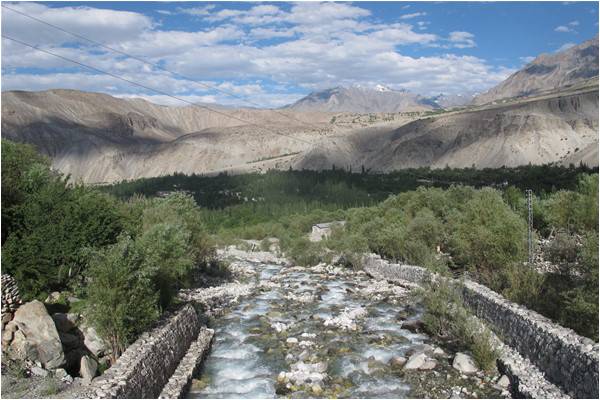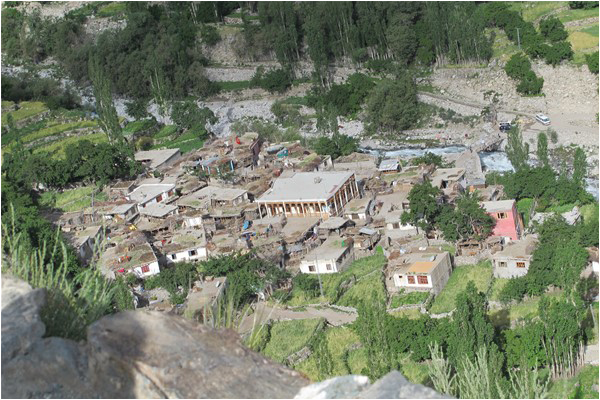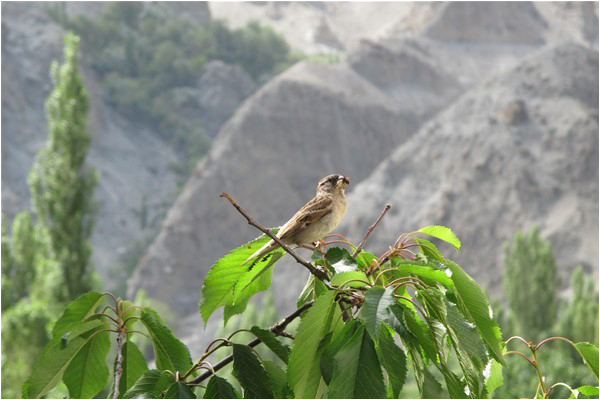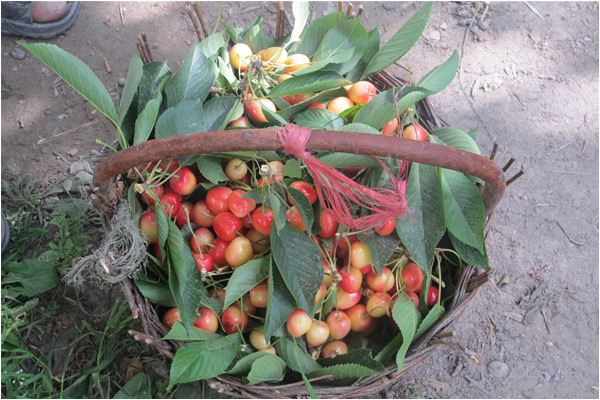
Last year, the apricots came later than usual in Gilgit-Baltistan. And when they arrived in the autumn, the harvest was destroyed by heavy showers and hail storms, leaving the farmers scratching their heads.
Rain and snow have also been coming at the strangest of times. Winters are growing shorter and the ice isn’t forming as fast as it used to. And so the farmers who live in this breathtaking land, surrounded by Rakaposhi and K2, Biaforo and Baltoro, are finding their world is deceptively fragile. The mountain ecosystems are reacting to the slightest disturbances.
For starters, average temperatures in the region have increased by 1.5?C per decade over the last 30 years, the GB government’s environmental protection agency (EPA) has discovered. This is close to the 1.8? C per decade temperature rise recorded in the Arctic, the highest across the planet over the same period. Yet, strangely enough, GB’s per capita carbon dioxide emissions are one-fourth the global average, according to EPA director Shahzad Shigri. This makes it clear to experts such as him that the region’s climate is heavily influenced by non-local factors.

The water for irrigation is the first resource to be disrupted. It comes from melting glaciers, but shorter winters with lower rates of ice formation have eaten into the amount of water available. Natural disasters such as landslides and glacial lake outburst floods have also increased in intensity and frequency, often displacing entire villages and destroying homes, agricultural land and livestock.
The region’s mostly narrow riverine valleys already impose harsh constraints on locals. “It’s easy to keep a buffalo in the plains, with all the flat land and grass,” says Salman Beg, CEO of the Aga Khan Cultural Services Pakistan, which has undertaken numerous heritage restoration projects in GB. But only 1.5% to 2% of the region’s total land area is suitable for farming, livestock-rearing and house construction. Growing periods are also shorter than in the plains, with land remaining fallow for long periods. Climate change stretches these limited means of livelihood past their breaking-point.
Yet, climatic shocks are not the only triggers of environmental degradation in the region. “Since the 1990s, deforestation and destruction of wildlife have increased in response to the growing population and shrinking livelihood opportunities,” says Irshad Abbasi, director of rural development and habitat at the Aga Khan Foundation, which spearheads many livelihood and conservation initiatives in the region. For example, substitution of the traditional sun-drying method in apricot processing with sulphurization techniques has raised sulphur dioxide levels in the air to around twice the nationally accepted limits, according to a study of ambient air commissioned by the GB EPA.
Housing demand, backed in part by growing tourism, has increased at a pace that can only be met by the use of modern construction techniques and materials. But according to Mr. Beg, modern buildings are often less energy-efficient because they lack the natural insulation of their traditional counterparts, which are made of poplar wood, stone and mud.

“Our region’s environment and society has experienced tremendous shifts in a little over a generation,” says Aziz Ali Dad, a local researcher and development practitioner originally from Khanaabad, in Hunza. As with many of these shifts, the migration of mostly young locals seeking to study and work outside GB has been taking place partly in response to the strain placed on traditional sources of livelihood due to environmental degradation. Successive waves of migration cut the youth off from the older generation, which are mostly involved in traditional occupations.
Old vs new
“We are at a point where the transfer of many traditional forms of knowledge and practice between generations has trickled to a halt,” adds Mr. Abbasi. Better road connectivity has also allowed consumer goods from down-country to be traded in the area, shifting consumer preferences and reducing demand for local alternatives.
According to Mr. Beg of the AKCSP, when his organization started the restoration of the 1,100-year old Baltit fort in 1991, local trades like carpentry and stone-masonry were becoming extinct because most new construction used concrete and CGI sheets from down-country.
“In many cases, modern materials are simply cheaper and easier to use, encouraging complete substitution of local alternatives,” explains Mr. Abbasi, adding that many people also consider traditional ways of doing things to be obsolete.
But experts are now saying that traditional systems of knowledge have to be brought back to help stem the tide of environmental degradation and loss of livelihood. “Traditional systems of practice can still be of relevance today, even in light of the unprecedented challenges posed by climate change,” says Mome Saleem, an anthropologist and climate researcher. Local traditions and beliefs can promote more sustainable patterns of environmental use.

The area, for example, used to have an elaborate system of beliefs and rules to regulate their relationship with nature. “The juniper forests were considered sacred,” explains Mr. Aziz Ali Dad. “And only trees of a certain size could be felled, with locals volunteering to ensure these rules were followed.” Such systems of environmental governance did not survive the abolishment of the Rajgiri feudal system after 1947. But, in some remote areas, traditional systems of communal forestry and rangeland management are still in place, according to Mr. Shigri, providing a ready model for the sustainable regulation of depleting natural resources.
Mr. Aziz Ali Dad also notes how his elders could tell which areas were less prone to landslides and avalanches, and hence more suitable for building. “But nowadays people are building in all sorts of disaster-prone areas,” he adds.
Ongoing development initiatives may also be enriched by local knowledge and practice. “Earlier, we used to encourage locals to burn the sea-buckthorn for fuel,” says Mr. Abbasi. “Studies have now revealed the medicinal value of this species, but it seems some locals knew this all along.”
Local wisdom can also be harnessed to increase the disaster resilience of communities. “People in the remote Bagrote valley have mastered the art of ‘glacier-marriage’ over decades,” says Mr. Shigri of the GB EPA. Glacier-marriage or glacier grafting in modern parlance, is a way of artificially starting or speeding up the formation of glaciers that has been highlighted by the Green Climate Fund’s GLOF project as a means of containing the risk of glacial-lake outbursts in the region.

Reviving traditional knowledge and practice in the context of climate change will be an uphill battle. There are only a few valleys in the region where traditional patterns of life still prevail. This makes documentation of traditional knowledge and practice all the more important. Such efforts have already been undertaken in other parts of the world, especially in the context of Inuit in the Arctic and the Maasai in Kenya. The EPA’s Mr. Shigri believes traditional knowledge and practice related to the environment may eventually become relevant in the context of the provincial government’s climate change response plan, which will be published soon.
Still, traditional knowledge and practice has its limitations. “It is important to refrain from thinking about traditional knowledge and practice as some silver bullet,” cautions Ms. Saleem. And it seems that the way forward lies in integrating the old with the new. “The real challenge is to employ modern techniques, materials and understandings—but not at the expense of traditional wisdom that still holds relevance today,” says Mr. Abbasi.
The writer is a researcher with the Sustainable Development Policy Institute and can be reached at ahmad.sdurrani@gmail.com
Rain and snow have also been coming at the strangest of times. Winters are growing shorter and the ice isn’t forming as fast as it used to. And so the farmers who live in this breathtaking land, surrounded by Rakaposhi and K2, Biaforo and Baltoro, are finding their world is deceptively fragile. The mountain ecosystems are reacting to the slightest disturbances.
For starters, average temperatures in the region have increased by 1.5?C per decade over the last 30 years, the GB government’s environmental protection agency (EPA) has discovered. This is close to the 1.8? C per decade temperature rise recorded in the Arctic, the highest across the planet over the same period. Yet, strangely enough, GB’s per capita carbon dioxide emissions are one-fourth the global average, according to EPA director Shahzad Shigri. This makes it clear to experts such as him that the region’s climate is heavily influenced by non-local factors.

The water for irrigation is the first resource to be disrupted. It comes from melting glaciers, but shorter winters with lower rates of ice formation have eaten into the amount of water available. Natural disasters such as landslides and glacial lake outburst floods have also increased in intensity and frequency, often displacing entire villages and destroying homes, agricultural land and livestock.
The region’s mostly narrow riverine valleys already impose harsh constraints on locals. “It’s easy to keep a buffalo in the plains, with all the flat land and grass,” says Salman Beg, CEO of the Aga Khan Cultural Services Pakistan, which has undertaken numerous heritage restoration projects in GB. But only 1.5% to 2% of the region’s total land area is suitable for farming, livestock-rearing and house construction. Growing periods are also shorter than in the plains, with land remaining fallow for long periods. Climate change stretches these limited means of livelihood past their breaking-point.
"The juniper forests were considered sacred," explains Mr. Dad. "And only trees of a certain size could be felled, with locals volunteering to ensure these rules were followed"
Yet, climatic shocks are not the only triggers of environmental degradation in the region. “Since the 1990s, deforestation and destruction of wildlife have increased in response to the growing population and shrinking livelihood opportunities,” says Irshad Abbasi, director of rural development and habitat at the Aga Khan Foundation, which spearheads many livelihood and conservation initiatives in the region. For example, substitution of the traditional sun-drying method in apricot processing with sulphurization techniques has raised sulphur dioxide levels in the air to around twice the nationally accepted limits, according to a study of ambient air commissioned by the GB EPA.
Housing demand, backed in part by growing tourism, has increased at a pace that can only be met by the use of modern construction techniques and materials. But according to Mr. Beg, modern buildings are often less energy-efficient because they lack the natural insulation of their traditional counterparts, which are made of poplar wood, stone and mud.

“Our region’s environment and society has experienced tremendous shifts in a little over a generation,” says Aziz Ali Dad, a local researcher and development practitioner originally from Khanaabad, in Hunza. As with many of these shifts, the migration of mostly young locals seeking to study and work outside GB has been taking place partly in response to the strain placed on traditional sources of livelihood due to environmental degradation. Successive waves of migration cut the youth off from the older generation, which are mostly involved in traditional occupations.
GB's per capita carbon dioxide emissions are one-fourth the global average, according to EPA director Shahzad Shigri. This makes it clear to experts such as him that the region's climate is heavily influenced by non-local factors
Old vs new
“We are at a point where the transfer of many traditional forms of knowledge and practice between generations has trickled to a halt,” adds Mr. Abbasi. Better road connectivity has also allowed consumer goods from down-country to be traded in the area, shifting consumer preferences and reducing demand for local alternatives.
According to Mr. Beg of the AKCSP, when his organization started the restoration of the 1,100-year old Baltit fort in 1991, local trades like carpentry and stone-masonry were becoming extinct because most new construction used concrete and CGI sheets from down-country.
“In many cases, modern materials are simply cheaper and easier to use, encouraging complete substitution of local alternatives,” explains Mr. Abbasi, adding that many people also consider traditional ways of doing things to be obsolete.
But experts are now saying that traditional systems of knowledge have to be brought back to help stem the tide of environmental degradation and loss of livelihood. “Traditional systems of practice can still be of relevance today, even in light of the unprecedented challenges posed by climate change,” says Mome Saleem, an anthropologist and climate researcher. Local traditions and beliefs can promote more sustainable patterns of environmental use.

The area, for example, used to have an elaborate system of beliefs and rules to regulate their relationship with nature. “The juniper forests were considered sacred,” explains Mr. Aziz Ali Dad. “And only trees of a certain size could be felled, with locals volunteering to ensure these rules were followed.” Such systems of environmental governance did not survive the abolishment of the Rajgiri feudal system after 1947. But, in some remote areas, traditional systems of communal forestry and rangeland management are still in place, according to Mr. Shigri, providing a ready model for the sustainable regulation of depleting natural resources.
Mr. Aziz Ali Dad also notes how his elders could tell which areas were less prone to landslides and avalanches, and hence more suitable for building. “But nowadays people are building in all sorts of disaster-prone areas,” he adds.
Ongoing development initiatives may also be enriched by local knowledge and practice. “Earlier, we used to encourage locals to burn the sea-buckthorn for fuel,” says Mr. Abbasi. “Studies have now revealed the medicinal value of this species, but it seems some locals knew this all along.”
Local wisdom can also be harnessed to increase the disaster resilience of communities. “People in the remote Bagrote valley have mastered the art of ‘glacier-marriage’ over decades,” says Mr. Shigri of the GB EPA. Glacier-marriage or glacier grafting in modern parlance, is a way of artificially starting or speeding up the formation of glaciers that has been highlighted by the Green Climate Fund’s GLOF project as a means of containing the risk of glacial-lake outbursts in the region.

Reviving traditional knowledge and practice in the context of climate change will be an uphill battle. There are only a few valleys in the region where traditional patterns of life still prevail. This makes documentation of traditional knowledge and practice all the more important. Such efforts have already been undertaken in other parts of the world, especially in the context of Inuit in the Arctic and the Maasai in Kenya. The EPA’s Mr. Shigri believes traditional knowledge and practice related to the environment may eventually become relevant in the context of the provincial government’s climate change response plan, which will be published soon.
Still, traditional knowledge and practice has its limitations. “It is important to refrain from thinking about traditional knowledge and practice as some silver bullet,” cautions Ms. Saleem. And it seems that the way forward lies in integrating the old with the new. “The real challenge is to employ modern techniques, materials and understandings—but not at the expense of traditional wisdom that still holds relevance today,” says Mr. Abbasi.
The writer is a researcher with the Sustainable Development Policy Institute and can be reached at ahmad.sdurrani@gmail.com

